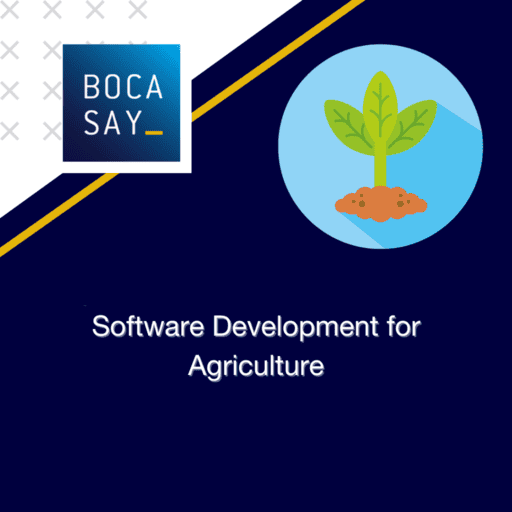Software Development for Agriculture
Farming and agriculture practices, instrumental in allowing humans to settle down and form today’s complex societies, have been around for centuries. The challenges of climate change, along with the struggle of feeding an ever-growing world population, have given rise to an entire industry of precision or smart farming.
From planting and harvesting crops, all the way to preventing disease outbreaks, agricultural software engineering can now provide farmers with long-term solutions.
The short story is that big data analytics is revolutionizing agriculture, enabling farmers to maximize and optimize crop production, as well as to increase their annual profits.
In this article, Bocasay, the leader offshore outsourcing company, will explain to you how dedicated software for agriculture has been a game-changer for food production in some of the world’s most challenging climates.

What is agriculture software development?
Agricultural software is specifically designed to offer extensive workflow management solutions to farmers. Farm management IT systems provide farmers with unprecedented control and insight over their lands and operations. All this is possible through an inspiring combination of engineering, computer science and physical science research and development.
Accessing real-time data, the agriculture sector deploys smart software engineering in order to perform the following tasks:
- Harvesting Time Optimization.
- Pest and Disease Control.
- Livestock Management.
- Keeping Records.
- Land Mapping.
- Risk Management.
- Crop Loss Prevention.
- Performance Monitoring.
How farmers benefit from using agricultural software
Agricultural technology has provided farmers with the following key benefits:
- Optimized use of water, fertilizer and pesticide.
- Simplification of harvesting process.
- Operational cost reduction.
- Efficient water and groundwater management.
- Higher crop productivity.
- Automated processes.
- Accurate food quality monitoring.
- Increased work safety conditions.
- Optimized storage and distribution.
- Streamlined communication between producers and markets.
- Reduced impact of farming on the environment.
𝔻𝕠 𝕪𝕠𝕦 𝕟𝕖𝕖𝕕 𝕒 𝕡𝕒𝕣𝕥𝕟𝕖𝕣 𝕔𝕒𝕡𝕒𝕓𝕝𝕖 𝕠𝕗 𝕡𝕣𝕠𝕕𝕦𝕔𝕚𝕟𝕘 𝕙𝕚𝕘𝕙 𝕢𝕦𝕒𝕝𝕚𝕥𝕪 𝕀𝕋 𝕤𝕠𝕝𝕦𝕥𝕚𝕠𝕟𝕤 𝕗𝕠𝕣 𝕪𝕠𝕦𝕣 𝕔𝕠𝕞𝕡𝕒𝕟𝕪? 𝔸𝕥 𝔹𝕠𝕔𝕒𝕤𝕒𝕪, 𝕠𝕦𝕣 𝕠𝕗𝕗𝕤𝕙𝕠𝕣𝕖 𝕠𝕦𝕥𝕤𝕠𝕦𝕣𝕔𝕚𝕟𝕘 𝕔𝕠𝕞𝕡𝕒𝕟𝕪, 𝕡𝕣𝕠𝕧𝕚𝕕𝕖 𝕔𝕦𝕥𝕥𝕚𝕟𝕘 𝕖𝕕𝕘𝕖 𝕤𝕠𝕗𝕥𝕨𝕒𝕣𝕖 𝕤𝕠𝕝𝕦𝕥𝕚𝕠𝕟𝕤 𝕗𝕠𝕣 𝕔𝕠𝕞𝕡𝕒𝕟𝕚𝕖𝕤 𝕒𝕣𝕠𝕦𝕟𝕕 𝕥𝕙𝕖 𝕨𝕠𝕣𝕝𝕕. 𝔾𝕖𝕥 𝕚𝕟 𝕥𝕠𝕦𝕔𝕙 𝕥𝕠 𝕗𝕚𝕟𝕕 𝕠𝕦𝕥 𝕙𝕠𝕨 𝕨𝕖 𝕔𝕒𝕟 𝕙𝕖𝕝𝕡 𝕪𝕠𝕦 𝕨𝕚𝕥𝕙 𝕪𝕠𝕦𝕣 𝕟𝕖𝕩𝕥 𝕡𝕣𝕠𝕛𝕖𝕔𝕥.
Why digital farming benefits everyone
An offshore outsourcing company like Bocasay, can combine machine learning algorithms with real-time data collected from fields, farmers use agricultural software in order to gain holistic insights on :
- Product supplies.
- Yields.
- Climatic conditions.
As embedded sensor networks collect real-time data on temperature patterns, soil moisture levels and soil nutrient availability, agricultural software is crucial because it allows farmers to optimize every aspect of the agricultural process. This translates to farmers being able to take faster and better decisions that can have a major impact on mass food production worldwide.
Agricultural data collected from farmers and corporations can be pooled together to allow learning algorithms to identify patterns that will help us solve future problems. Disease outbreaks and low-yield issues could be identified and ‘fixed’ much faster because of insights provided by the analysis of data collected from past similar incidents. In addition, providing constant estimations for greenhouse gas emissions, agricultural data collection, allows farmers to test methods and techniques that reduce CO2 emissions and ultimately benefit the environment.
The bottom line is, that by helping farmers reduce the use of water, fertilizers and pesticides, smart software solutions can essentially provide healthier food for more people, as well as help with protecting our natural environment.
Examples of Agro-Technology
Agricultural software development focuses on the following technology areas:
Precision Farming: Mostly about optimizing efficiency, precision farming is a relatively new trend that helps farmers with every part of the crop seeding, growing and harvesting process. Software dealing with precision farming can also result in major operational cost reduction. The world’s industry for precision agriculture is projected to be worth $43.4 billion by 2025.
Farm Automation: Increasing the efficiency and work safety of any agricultural organization, automated farm processes include robotic innovations such as drone aircraft, autonomous tractors, computer visualizations, as well as automatic seeding and watering devices. Not only do automated solutions often increase overall agricultural output, they also require minimal human support.
Intelligent Sensors: Smart data-collecting sensors found in interconnected agricultural fields are at the frontline of precision farming. Providing valuable information on soil humidity and nutrient levels, farmers know exactly which field areas require more water or fertilizer. Sensors help to minimize the overall impact of farming on the environment and enable farmers to establish efficient resource management.
Weather Tracking: TV weather reports have never been much help to farmers around the world. These days, advanced weather-tracking stations can deliver dedicated and more accurate weather updates directly to farmers’ smartphones. This can help farmers to prepare with preventing crop losses and to minimize the damage caused by insufficient weather estimations.

Food Tracing: Software dealing with traceability for the food production industry can help with
- Eliminating food fraud.
- Implementing food production safety rules
- Increasing the overall efficiency of supply chains and logistics.
For example, a technology such as blockchain can establish digital ledgers that provide accurate data on product locations along the entire supply chain.
Satellite Imaging: Today’s satellites can provide farmers with high-performance monitoring tools that offer unprecedented image resolutions. Resulting in severe cost and time reductions, farmers can use satellite imaging technologies to remotely monitor their field crops in amazing detail. Combined with field-based data-gathering sensors, agricultural software uses satellite imaging to essentially establish what we now call precision farming.
Agricultural Drones: Another inspiring technology area for agriculture is the use of agricultural drones. Flying above, they help create digital surface models of a farm, which essentially enables next-level evaluation abilities with the precise measuring and tracking of a wide range of agricultural conditions. For small-scale farming, drones are a powerful and cost-effective alternative to satellite imaging.